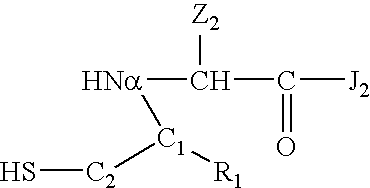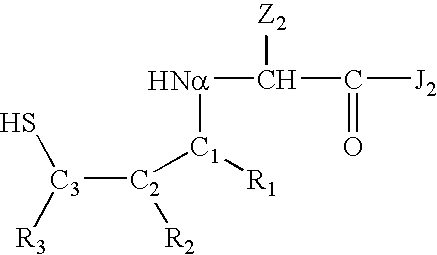Polymer-modified synthetic proteins
a technology of synthetic proteins and polypeptides, which is applied in the direction of peptides/protein ingredients, animal/human proteins, peptides, etc., can solve the problems of lack of post-translational modifications that are normally found in the natural production form of the protein, lack of modification can have a significant negative impact on the pharmaceutical properties of the protein, and the use of recombinant dna techniques is not universally successful
- Summary
- Abstract
- Description
- Claims
- Application Information
AI Technical Summary
Benefits of technology
Problems solved by technology
Method used
Image
Examples
example 1
Synthesis of Synthetic Erythropoiesis Stimulating Protein SEP-0
[0388] A Synthetic Erythropoiesis Stimulating Protein (SEP) was Synthesized.
[0389] The sequence of the full-length synthesized protein (designated “SEP-0 (1-166)” is:
(SEQ ID NO:1)APPRLICDSRVLERYLLEAKEAEKITTGCAEHCSLNEKITVPDTKVNFYAWKRMEVGQQAVEVWQGLALLSEAVLRGQALLVKSSQPWψPLQLHVDKAVSGLRSLTTLLRALGAQKψAISPPDAASAAPLRTITADTFRKLFRVYSNFLRGKLKLYTGEACRTGDR
where ψ denotes a non-native amino acid residue consisting of a cysteine that is carboxymethylated at the sulfhydryl group. The SEP-0 protein was synthesized in solution from four polypeptide segments:
Segment SEP-0:1 (GRFN 1711; composed of residues 1-32 of SEQ ID NO:1): [0390] APPRLICDSR VLERYLLEAK EAEKITTGCA EH-thioester
Segment SEP-0:2 (GRFN 1712, composed of residues 33-88 of SEQ ID NO:1): [0391] CSLNEKITVP DTKVNFYAWK RMEVGQQAVE VWQGLALLSE AVLRGQALLV KSSQPW-thioester (where Cys33 is Acm protected)
Segment SEP-0:3 (GRFN 1713, composed of residues 89-116 of SEQ ID NO:1): ...
example 2
Synthesis of Synthetic Erythropoiesis Stimulating Protein SEP-1-L30
[0404] A second synthetic erythropoiesis stimulating protein (designated SEP-1-L30) was synthesized to contain oxime-forming groups at positions 24 and 126 of SEP-0. These groups were then used to form SEP-1-L30, in which linear (EDA-Succ-)18 carboxylate (EDA=(4,7,10)-trioxatridecane-1,13diamine, also called TTD; Succ=—CO—CH2CH2CO—) polymers have been joined to the protein backbone. The sequence of the full-length SEP-1 (1-166) is:
(SEQ ID NO:2)APPRLICDSRVLERYLLEAKEAEKOXITTGCAEHCSLNEKITVPDTKVNFYAWKRMEVGQQAVEVWQGLALLSEAVLRGQALLVKSSQPWψPLQLHVDKAVSGLRSLTTLLRALGAQKψAISPPDAAKOXAAPLRTITADTFRKLFRVYSNFLRGKLKLYTGEACRTGDR
where ψ denotes an non-native amino acid residue consisting of a cysteine that is carboxymethylated at the sulfhydryl group, and where Kox denotes a non-native lysine that is chemically modified at the ε-amino group with an oxime linker group coupled to a designated water-soluble polymer through an oxime bo...
example 3
Synthesis of Synthetic Erythropoiesis Stimulating Protein SEP-1-L26
[0426] A third synthetic erythropoiesis stimulating protein (designated SEP-1-L26) was synthesized to contain oxime-forming groups at positions 24 and 126 of SEP-0. These groups were then used to form SEP-1-L26, in which the linear polymers (EDA-Succ)18 carboxylate and (EDA-Succ)6-amide have been joined to the protein backbone through oxime linkages at positions 24 and 126, respectively. The sequence of the full-length SEP-1 (1-166) is:
(SEQ ID NO:2)APPRLICDSRVLERYLLEAKEAEKOXITTGCAEHCSLNEKITVPDTKVNFYAWKRMEVGQQAVEVWQGLALLSEAVLRGQALLVKSSQPWψPLQLHVDKAVSGLRSLTTLLRALGAQKψAISPPDAAKOXAAPLRTITADTFRKLFRVYSNFLRGKLKLYTGEACRTGDR
[0427] Where ψ denotes an non-native amino acid residue consisting of a cysteine that is carboxymethylated at the sulfhydryl group, and where Kox denotes a non-native lysine that is chemically modified at the ε-amino group with an oxime linker group coupled to a designated water-soluble polymer through ...
PUM
| Property | Measurement | Unit |
|---|---|---|
| molecular weight | aaaaa | aaaaa |
| molecular weight | aaaaa | aaaaa |
| molecular weight | aaaaa | aaaaa |
Abstract
Description
Claims
Application Information
 Login to View More
Login to View More - R&D
- Intellectual Property
- Life Sciences
- Materials
- Tech Scout
- Unparalleled Data Quality
- Higher Quality Content
- 60% Fewer Hallucinations
Browse by: Latest US Patents, China's latest patents, Technical Efficacy Thesaurus, Application Domain, Technology Topic, Popular Technical Reports.
© 2025 PatSnap. All rights reserved.Legal|Privacy policy|Modern Slavery Act Transparency Statement|Sitemap|About US| Contact US: help@patsnap.com



